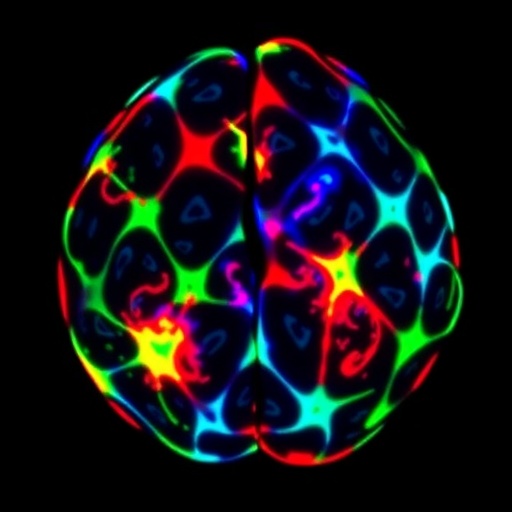In a groundbreaking advancement for Alzheimer’s disease research, scientists have unveiled a new frontier of chemical imaging that elucidates the complex polymorphism of amyloid-beta (Aβ) plaques throughout the Alzheimer’s disease spectrum. This innovative work, published in Nature Communications, promises to redefine our understanding of the pathological heterogeneity that underpins the disease and offers a promising avenue for the development of targeted therapeutic strategies.
Alzheimer’s disease, a neurodegenerative disorder characterized by progressive memory loss and cognitive decline, has long been associated with the accumulation of Aβ plaques in the brain. However, the structural and chemical diversity of these plaques — known as polymorphism — has obscured researchers’ ability to fully comprehend their role in disease progression and variability among patients. The team, led by Koutarapu, Ge, and Dulewicz, leverages cutting-edge chemical imaging techniques to map this polymorphism with unprecedented precision.
Central to the study is the application of hyperspectral stimulated Raman scattering (SRS) microscopy, a technique that enables label-free, chemically specific imaging at high spatial resolution. By capturing the vibrational spectra intrinsic to molecular bonds within the plaques, SRS provides a detailed chemical signature, facilitating the discrimination of diverse Aβ conformations and their microenvironmental context. This method surpasses traditional histological staining by preserving the native chemical composition, thereby avoiding the artifacts inherent to external labeling.
The researchers systematically analyzed brain tissues from a broad cohort of Alzheimer’s patients, spanning early to advanced stages of the disease. Their data reveal a spectrum of Aβ plaque morphologies and compositions, challenging the prevailing notion of a singular, uniform plaque structure. Instead, the plaques demonstrate a continuum of chemical states, varying in protein folding patterns, lipid content, and associated co-factors such as metal ions.
Importantly, these chemical variations correlate with distinct pathological features and clinical manifestations. For instance, plaques exhibiting certain lipid-protein interactions were found predominantly in patients with rapid cognitive decline, suggesting that polymorphism may drive differences in disease aggressiveness. This insight highlights the necessity of considering plaque heterogeneity when designing diagnostic markers and treatment approaches.
Further, the team integrated their chemical imaging data with mass spectrometry and advanced bioinformatics analyses to elucidate the molecular underpinnings of plaque diversity. Mass spectrometry provided complementary validation by identifying specific peptide sequences and post-translational modifications present in the different plaque subtypes. This multi-modal approach allowed for a comprehensive molecular atlas of Aβ polymorphism.
One particularly striking discovery was the identification of distinct subpopulations of plaques enriched in metal ions such as zinc and copper. The presence of these metals is known to influence Aβ aggregation and toxicity, implicating them in modulating the biochemical landscape of plaques. The precise localization and quantification achieved through chemical imaging suggest new targets for metal-chelating therapies.
Moreover, the study advances the concept of Alzheimer’s disease as a spectrum disorder, wherein the heterogeneity of Aβ plaques reflects underlying biological complexity rather than a monolithic pathological process. This realization compels a paradigm shift, advocating for personalized medicine approaches tailored to the unique plaque compositions and their associated pathogenic mechanisms in individual patients.
The technical prowess demonstrated in this work paves the way for dynamic, in situ studies of plaque formation and evolution. By enabling longitudinal tracking of chemical changes in plaques within experimental models, researchers can decode the temporal sequence of pathogenic events, informing the timing and nature of therapeutic interventions.
Beyond its implications for Alzheimer’s disease, the chemical imaging strategies showcased are broadly applicable to other protein aggregation disorders, including Parkinson’s disease and amyotrophic lateral sclerosis. The ability to resolve polymorphic protein aggregates chemically offers a vital tool to uncover disease-specific molecular signatures and interventional targets.
The broader scientific community has responded with enthusiasm to these findings, recognizing the fusion of advanced spectroscopy, imaging, and computational analysis as a blueprint for next-generation neuropathology. Collaborative efforts are already underway to translate these laboratory discoveries into clinical diagnostics, harnessing the chemical phenotyping of plaques to improve early detection and monitoring of disease progression.
In conclusion, this landmark study realizes a critical gap in Alzheimer’s research by chemically delineating the polymorphism of Aβ plaques at an unprecedented scale and resolution. The integration of hyperspectral SRS microscopy with complementary molecular techniques marks a new epoch in the detailed characterization of neuropathological hallmarks. As we deepen our understanding of Alzheimer’s heterogeneity through such innovative imaging, the prospect of precision therapeutics tailored to distinct plaque subtypes becomes increasingly attainable, offering renewed hope in the battle against this devastating disease.
Subject of Research: Amyloid-beta plaque polymorphism in Alzheimer’s disease revealed by chemical imaging.
Article Title: Chemical imaging delineates Aβ plaque polymorphism across the Alzheimer’s disease spectrum.
Article References:
Koutarapu, S., Ge, J., Dulewicz, M. et al. Chemical imaging delineates Aβ plaque polymorphism across the Alzheimer’s disease spectrum. Nat Commun 16, 3889 (2025). https://doi.org/10.1038/s41467-025-59085-7
Image Credits: AI Generated




